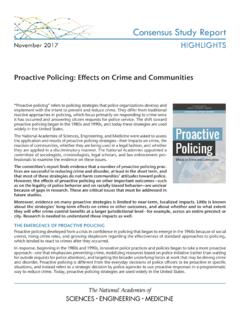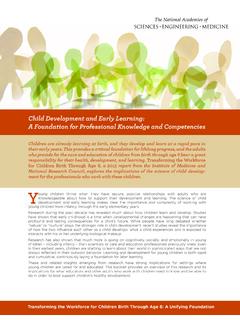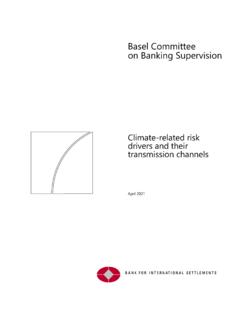Transcription of ECOLOGICAL IMPACTS OF CLIMATE - National Academies …
1 Life on Earth is profoundly affected by the planet's CLIMATE . Animals, plants, and other living beings around the globe are moving, adapting, and, in some cases, dying as a direct or indirect result of environmental shifts asso- ciated with our changing CLIMATE disrupting intricate interactions among Earth's species, with profound implications for the natural systems on which E C O L O G I CA L I M PAC T S O F. CLIMATE . humans depend. CLIMATE change is happening on a global scale, but the ECOLOGICAL IMPACTS change . are often local. To illuminate how CLIMATE change has affected species and ecosystems across the United States, this booklet, based on the conclu- sions of an independent, expert committee of the nation's leading scientists, describes some of the ECOLOGICAL IMPACTS of CLIMATE change that have already been observed right in our own backyard.
2 National Academy of Sciences National Academy of Engineering Institute of Medicine National Research Council About this Booklet About the National Academies This booklet is based on the report ECOLOGICAL IMPACTS of CLIMATE change (2008), The National Academies the National Academy of Sciences, National by the Committee on ECOLOGICAL IMPACTS of CLIMATE change . The booklet was Academy of Engineering, Institute of Medicine, and the National Research developed by Anne Frances Johnson and designed by Francesca Moghari. Fund- Council provide a public service by working outside the framework of ing for the report and this product was provided by the United States Geological government to ensure independent advice on matters of science, technology, Survey.
3 And medicine. They enlist committees of the nation's top scientists, engineers, and other experts all of whom volunteer their time to study specific concerns. The results of these deliberations are authoritative, peer-reviewed reports that have inspired some of the nation's most significant efforts to improve the health, education, and welfare of the population. COMMITTEE ON ECOLOGICAL IMPACTS OF CLIMATE change . Christopher B. Field, Chair, Carnegie Institution for Science Donald F. Boesch, University of Maryland Center for Environmental Science F. Stuart (Terry) Chapin III, University of Alaska, Fairbanks Peter H. Gleick, Pacific Institute Anthony C.
4 Janetos, University of Maryland, College Park Jane Lubchenco, Oregon State University Jonathan T. Overpeck, University of Arizona, Tuscon Learn More Camille Parmesan, University of Texas, Austin Terry L. Root, Stanford University Visit our website for expert reports, basic information, and Steven W. Running, University of Montana, Missoula current activities at the National Academies Stephen H. Schneider, Stanford University National Research Council Staff: Ann Reid, Study Director Frances E. Sharples, Director, Board on Life Sciences Anne Frances Johnson, Communications Officer Amanda Cline, Senior Program Assistant Cover photos and images on pages 1, 2, 3, 4, 5, 6, 7, 8, 14, 15, 18, 24, and 27: 2009 JupiterImages.
5 Copyright 2009 by the National Academy of Sciences. What Do We Know About CLIMATE change ? 4. What Are the ECOLOGICAL IMPACTS of CLIMATE change ? 8. CLIMATE change in Your Backyard 11. The Pacific Coastline 12. Alaska and the Arctic 14. The Western Mountains 16. The Southwestern Deserts 18. The Central United States 20. The Southeast 22. The Northeast 24. What Does the Future Hold.. and What Can We Do? 25. E c o l o g i ca l IMPACTS T. he world's CLIMATE is changing, and it will continue to change throughout the 21st century and beyond. Rising tem- peratures, new precipitation patterns, and other changes are already affecting many aspects of human society and the natural world.
6 CLIMATE change is transforming ecosystems on an extraordinary scale, at an extraordinary pace. As each species responds to its changing environment, its interactions with the physical world and the organisms around it change too. This triggers a cascade of IMPACTS through- out the entire ecosystem. These IMPACTS can include expansion of species into new areas, intermingling of formerly nonoverlapping species, and even species extinctions. CLIMATE change is happening on a global scale, but the ECOLOGICAL IMPACTS are often local and vary from place to place.. o f C l i mate C h an g e To illuminate how CLIMATE change has affected particular species and ecosystems, this booklet presents a series of examples that have already been observed across the United States.
7 Human actions have been a primary cause of the CLIMATE changes observed today. Fortunately, though, humans are also capable of changing their behavior in ways that can reduce the rate of future CLIMATE change and help wild species adapt to CLIMATE changes that cannot be avoided. How we approach other human activities that affect ecosystems, such as agriculture, water management, trans- portation, fishing, biological conservation, and many other activities will influence the ways and the extent to which CLIMATE change will alter the natural world and the ecosystems on which we depend.. What Do We Know About CLIMATE change ? The Earth Is Getting Warmer A relatively rapid increase in temperature has been documented during the past century, both at Earth's surface and in the oceans.
8 The average surface temperature for Earth as a whole has risen some Fahrenheit since 1850, the starting point for a global network of thermometers. If emis- sion rates for greenhouse gases (which trap heat inside Earth's atmosphere) con- tinue on their current track, models indi- cate that the globe will be to F. warmer by 2100 than it was in 1990. The average change in temperature per decade from 1950 to 2005, in degrees Celsius. (If the scale were in F, it would go from .72 to .72.). Image courtesy of the Joint Institute for the Study of the Atmosphere and Ocean, University of Washington.. Human Activities Are Contributing to CLIMATE change The physical processes that cause CLIMATE change are scientifically well documented: both human activities and natural variability are contributing to global and regional warming.
9 According to the Intergovernmental Panel on CLIMATE change , whose documents are considered the most authorita- tive source for information on the state of the science on CLIMATE change , it is very likely that most of the observed warming over the past 50 years is the result of increased greenhouse gases generated by human activities. Numerous expert reports from the National Research Council have supported this conclusion as well. Carbon dioxide and other greenhouse gases, which trap heat inside Earth's atmosphere, have increased dramatically The release of greenhouse gases has increased significantly since the Industrial since the Industrial Revolution compared Revolution, mostly from the burning of fossil fuels for energy, agriculture, indus- to relatively stable concentrations over the trial processes, and transportation.
10 Carbon dioxide, a major greenhouse gas, is past 10,000 years. Adapted from CLIMATE change 2007: The Physical Science increasing in the atmosphere faster than at any time measured in the past, Basis. Working Group 1 Contribution to the 4th Assessment having grown by about 35 percent since 1850. Two other greenhouse gases, Report of the Intergovernmental Panel on CLIMATE change . Figure Cambridge University Press. methane and nitrous oxide, are present in the atmosphere at much lower concentrations than carbon dioxide but have increased rapidly. Methane has increased by 150 percent; in addition, it is 25 times more effective per molecule at trapping heat than carbon dioxide.











